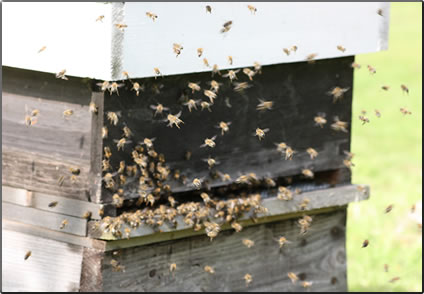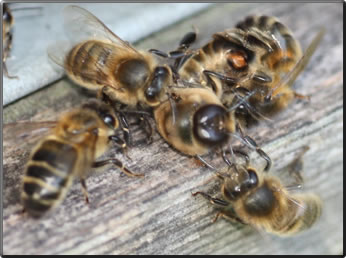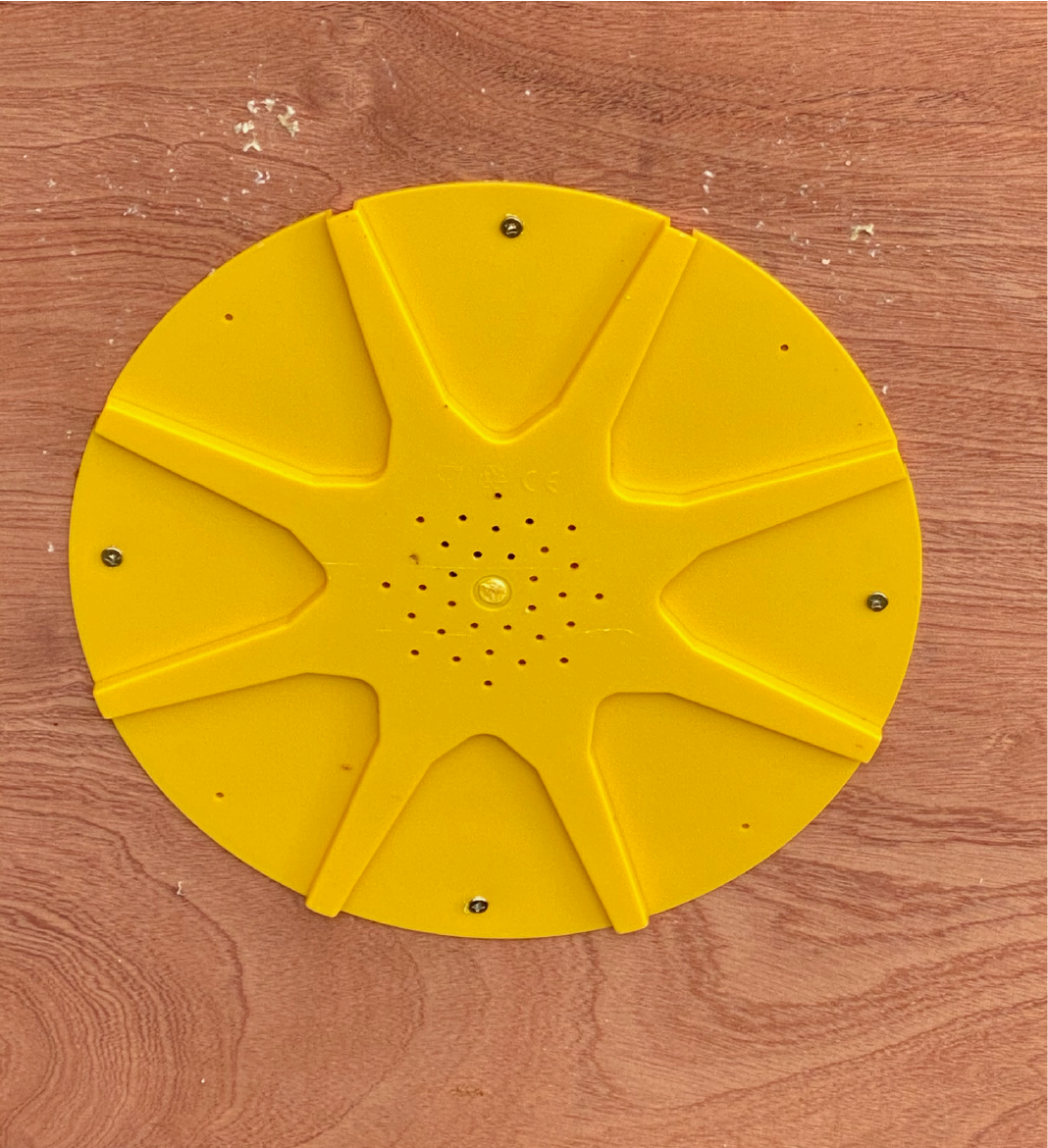Seasons: Autumn
September, October and November
My feeders are described as the rapid English type by Thorne's. They are very sturdy white plastic with a central dome which sits on the hole on the crown board. The dome is covered by a transparent cup which allow the feeding bees to be observed. Each feeder holds about 6 litres of solution.
The 9 kg sugar is given over a period of about 5 days in three lots: 4kg, 3 kg, and finally 2 kg. These quantities are dissolved respectively in 2520 ml , 1890 ml , and 1260 ml warm water. If the water used is about 1/3 boiling and 2/3 cold water the final temperature is about 30 °C. This warm syrup is readily welcomed by the bees. The first lot is given to be bees late in the evening otherwise the bees may go looking around the apiary for this new source of nectar; this could encourage robbing. It is remarkable how quickly this syrup is taken down and stored. The feeding is usually over in 5 days. The bees will readily clean up the last remaining syrup in the feeder if the cup is removed.
Formic acid treatment for varroa
After feeding the colonies are treated for varroa with formic acid.
The method is described under (Varroa 2) and some results shown in (Varroa 3)
Re queening
After the varroa treatment any re queening can conveniently takes place at this time (see Re queening.)
The Queen and egg laying
The rate at which the queen lays her eggs decreases rapidly at this time. So the bees spend a shorter time on brood rearing and put more energy in preparing for winter. The brood frames are now filled with winter stores. This characteristic of the black bee gives them an advantage in that all pollen and nectar is stored. The lack of brood at this time can be somewhat deceptive for the inexperienced beekeeper in so far it might be concluded that the colony is queen less. This lack of brood, however, triggers the bees in their transformation to the winter state.
Pollen and Nectar and the Winter Worker
In these three months the bees bring in copious amounts of pollen in preparation for winter. Nearly all of this pollen is eaten by the bees by October and stored in their bodies as fats and protein. Winter bees so produced are physiologically different to the summer bee; so that by springtime they are still capable of looking after the new brood i.e.. acting as nurse bees.
To be more explicit the summer worker bee from emerging as a grub to leaving the hive 13 days later as a forager goes through a series of hive tasks. The winter worker on the other hand has the job of seeing the colony through the long cold winter at the end of which it is able to multi task i.e.. take on anyone of the hive tasks.
Surplus pollen at this time is stored during the winter in the comb and covered over with honey before each cell is capped; the honey preventing the pollen from going mouldy. This pollen is essential being used in the spring to feed the new brood.
The nectar from the ivy being especially rich is eagerly sought out by the bees in October; the pollen is a bright yellow.
The 9 kg sugar is given over a period of about 5 days in three lots: 4kg, 3 kg, and finally 2 kg. These quantities are dissolved respectively in 2520 ml , 1890 ml , and 1260 ml warm water. If the water used is about 1/3 boiling and 2/3 cold water the final temperature is about 30 °C. This warm syrup is readily welcomed by the bees. The first lot is given to be bees late in the evening otherwise the bees may go looking around the apiary for this new source of nectar; this could encourage robbing. It is remarkable how quickly this syrup is taken down and stored. The feeding is usually over in 5 days. The bees will readily clean up the last remaining syrup in the feeder if the cup is removed.
Formic acid treatment for varroa
After feeding the colonies are treated for varroa with formic acid.
The method is described under (Varroa 2) and some results shown in (Varroa 3)
Re queening
After the varroa treatment any re queening can conveniently takes place at this time (see Re queening.)
The Queen and egg laying
The rate at which the queen lays her eggs decreases rapidly at this time. So the bees spend a shorter time on brood rearing and put more energy in preparing for winter. The brood frames are now filled with winter stores. This characteristic of the black bee gives them an advantage in that all pollen and nectar is stored. The lack of brood at this time can be somewhat deceptive for the inexperienced beekeeper in so far it might be concluded that the colony is queen less. This lack of brood, however, triggers the bees in their transformation to the winter state.
Pollen and Nectar and the Winter Worker
In these three months the bees bring in copious amounts of pollen in preparation for winter. Nearly all of this pollen is eaten by the bees by October and stored in their bodies as fats and protein. Winter bees so produced are physiologically different to the summer bee; so that by springtime they are still capable of looking after the new brood i.e.. acting as nurse bees.
To be more explicit the summer worker bee from emerging as a grub to leaving the hive 13 days later as a forager goes through a series of hive tasks. The winter worker on the other hand has the job of seeing the colony through the long cold winter at the end of which it is able to multi task i.e.. take on anyone of the hive tasks.
Surplus pollen at this time is stored during the winter in the comb and covered over with honey before each cell is capped; the honey preventing the pollen from going mouldy. This pollen is essential being used in the spring to feed the new brood.
The nectar from the ivy being especially rich is eagerly sought out by the bees in October; the pollen is a bright yellow.
Feeding for Winter
Each black bee colony requires 30 - 35 lb. of sealed stores to see it through the winter and provide sufficient stores for the initial spring build up.
At the start of September each colony receives 20 lb. of sugar which provides about 24 lb. of sealed stores. It is assumed that the colony can make up the deficit from the autumn forage mainly from the mature ivy.
 The formula for winter feeding is 2 lb. sugar dissolved in 1 pint of warm water.
The formula for winter feeding is 2 lb. sugar dissolved in 1 pint of warm water.
 The metric equivalent is 0.90 kg in 570 ml.
The metric equivalent is 0.90 kg in 570 ml.
 Keeping the same ratio 1 kg is dissolved in 630 ml warm water.
Keeping the same ratio 1 kg is dissolved in 630 ml warm water.
 This gives a solution which is 62% in sugar w/w.
This gives a solution which is 62% in sugar w/w.
 20 lb. sugar equates to 9 kg.
20 lb. sugar equates to 9 kg.
The addition of thymol to this syrup has two benefits:
thymol prevents the fermentation of the syrup in the brood frames if the syrup remains unsealed. Fermentation can cause the bees to have dysentery.
And thymol prevents the formation of the black mould which is often formed if any syrup remains unused.
Dissolve 20 g thymol in 100 ml surgical spirit.
Add 1 ml of this solution to 2 litres of the syrup and stir.
The syrup can now be kept indefinitely in a sealed container.
Each black bee colony requires 30 - 35 lb. of sealed stores to see it through the winter and provide sufficient stores for the initial spring build up.
At the start of September each colony receives 20 lb. of sugar which provides about 24 lb. of sealed stores. It is assumed that the colony can make up the deficit from the autumn forage mainly from the mature ivy.
The addition of thymol to this syrup has two benefits:
thymol prevents the fermentation of the syrup in the brood frames if the syrup remains unsealed. Fermentation can cause the bees to have dysentery.
And thymol prevents the formation of the black mould which is often formed if any syrup remains unused.
Dissolve 20 g thymol in 100 ml surgical spirit.
Add 1 ml of this solution to 2 litres of the syrup and stir.
The syrup can now be kept indefinitely in a sealed container.
Honey Extraction
The supers are removed and the honey extracted at the beginning of September when the Himalayan balsam is finishing. An 8-way bee escape has proved to be invaluable in clearing the supers. An eke is placed over the queen excluder and the bee escape over the eke and the set up left for a day. The escape works like magic.
The cappings are almost pure white. Immediately after extracting, the honey is free flowing and is passed firstly through a metal sieve which retain the larger bits of wax, and then through a fine conical straining bag. This latter process can be quite slow.
After straining the honey is left in a warm place to settle overnight and then bottled.
The cappings are fed back to the bees usually a nuc or a small colony in a feeder. After a few days with the bees, the honey has been removed and the wax is added to near boiling water. The now clean melted wax floats to the top of the water, is allowed to cool and a very nice wax pancake obtained.
The supers are removed and the honey extracted at the beginning of September when the Himalayan balsam is finishing. An 8-way bee escape has proved to be invaluable in clearing the supers. An eke is placed over the queen excluder and the bee escape over the eke and the set up left for a day. The escape works like magic.
The cappings are almost pure white. Immediately after extracting, the honey is free flowing and is passed firstly through a metal sieve which retain the larger bits of wax, and then through a fine conical straining bag. This latter process can be quite slow.
After straining the honey is left in a warm place to settle overnight and then bottled.
The cappings are fed back to the bees usually a nuc or a small colony in a feeder. After a few days with the bees, the honey has been removed and the wax is added to near boiling water. The now clean melted wax floats to the top of the water, is allowed to cool and a very nice wax pancake obtained.
Play flights
Young bees from the last of the brood can be seen on play flights at this time. These are an especially welcome sight as these are the bees which will take the colony through the winter.
The bees from a number of hives often emerge together in the early afternoon during a sunny spell. They fly excitedly in front of and around each hive learning the position of the hive and its orientation in the apiary.
During these play flights the older foraging bees many carrying pollen can be seen flying through the masses.
After about 10 minutes the young bees disappear back into the hive and all appears quiet again.
Young bees from the last of the brood can be seen on play flights at this time. These are an especially welcome sight as these are the bees which will take the colony through the winter.
The bees from a number of hives often emerge together in the early afternoon during a sunny spell. They fly excitedly in front of and around each hive learning the position of the hive and its orientation in the apiary.
During these play flights the older foraging bees many carrying pollen can be seen flying through the masses.
After about 10 minutes the young bees disappear back into the hive and all appears quiet again.
A used super placed underneath the brood box (nadiring) will give extra protection to the cluster against adverse weather for the duration of the winter.
Mouseguards
Finally mouseguards are fixed and each hive treated with linseed oil as a wood preservative. And then strapped down for the winter.
Mouseguards
Finally mouseguards are fixed and each hive treated with linseed oil as a wood preservative. And then strapped down for the winter.
Drones expelled
On late August afternoons some excitement can be observed at the hives. The workers are very busy dragging drones out of each hive. At this time of the season the drones have fulfilled their purpose and are given short shrift by the workers.
The photo shows one particular drone being roughly handled by six workers before being tossed off the alighting board. (One bee (top-right) appears to be carrying a varroa mite!)
This behaviour is commonly called the massacre of the drones.
On late August afternoons some excitement can be observed at the hives. The workers are very busy dragging drones out of each hive. At this time of the season the drones have fulfilled their purpose and are given short shrift by the workers.
The photo shows one particular drone being roughly handled by six workers before being tossed off the alighting board. (One bee (top-right) appears to be carrying a varroa mite!)
This behaviour is commonly called the massacre of the drones.
 Thorne's English feeder
Thorne's English feeder

 The underside of the 8-way bee escape
The underside of the 8-way bee escape